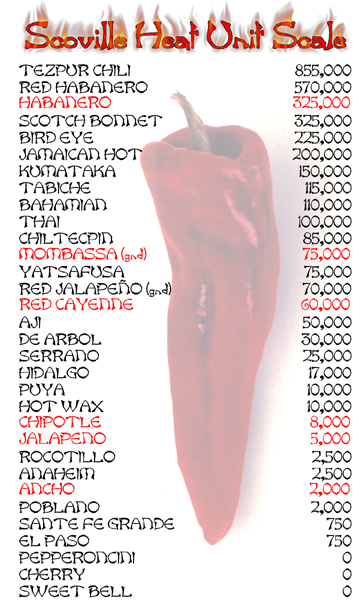As a person who has a fondness for peppery foods particularly highly spiced sauces and curries, I just love to experiment with different fiery chili peppers available in the market. What intrigues me is how each of the chili peppers differs from the other in piquancy. Do you know that there actually exist methods to inform you how spicy your preferred chili pepper in food is?

Devised by Wilbur Scoville, the Scoville heat scale informs you about the tanginess each chili contains owing to its content of a particular chemical compound called capsaicin (8-methyl N-vanillyl 6-nonenamide). Following the Scoville Organoleptic Test formulated in 1912, which determines the pungency of a chili pepper, this Scoville scale is developed. In the test, the pungency is estimated by diluting a chili pepper solution with sugar water until the chili loses all its spiciness and an individual’s palate no longer registers any piquancy. A panel of tasters performs the tasting in the test where usually five tasters are employed.
However, the biggest drawback of the Scoville scale is its dependence on an individual’s palate that can be a source of error and imprecision. Nevertheless, it gives you an idea of how hot the commonly consumed chili peppers are. These sources of errors have to be borne in mind while determining the Scoville heat units (SHU) for each type of chili. Listed below are Scoville heat units (SHU) after determining the millions of drops of water-sugar solution required to subside the hotness of some well-known chili peppers.

From the table it is clear that the fieriest of them all is the Tezpur chili also known as Naga Jolokia whereas the sweet bell, cherry and pepperoncini chili peppers have no piquancy at all. The units are indicative of how much the chili pepper solution has to be diluted with sugar solution so that its spiciness is no longer detectable. This means the Tezpur chili has to be subjected to 855,000-fold sugar dilution so that it is no longer registering any hint or trace of spiciness.
However, to get a precise measurement of a chili’s spiciness, the method of High performance liquid chromatography (HPLC) is used. In this method, the compounds that impart piquancy to the chili pepper are extracted and analyzed in the HPLC device. In this method, the pungency is reported not in Scoville units but in ASTA pungency units where one part capsaicin per million is equivalent to about 15 Scoville units. ASTA pungency units can be converted into Scoville units by multiplying them by 15. The method not only tells you total “heat” present but also individual capsaicinoids present in a chili pepper. However, this method is very expensive as compared to the Scoville Organoleptic Test.
After learning about this all I can say is that it is indeed wonderful to know the intricacies simple food elements we consume can hold.
Image: Satansbreath, Jupiterimages
Via: Egconsult, Wikipedia



